Categories: Featured Articles » Electrician Secrets
Number of views: 116813
Comments on the article: 6
Methods for terminating cable and wire cores
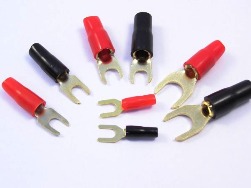 Have you ever observed fused plastic enclosures of apartment switchboards? Do you know the kind of brutally charred and charred zero wires? Well, maybe you watched a dull sight, which is a hedgehog sticking out in different directions from the wires of wires and cables, planted in an access panel under a common bolt, even without a washer?
Have you ever observed fused plastic enclosures of apartment switchboards? Do you know the kind of brutally charred and charred zero wires? Well, maybe you watched a dull sight, which is a hedgehog sticking out in different directions from the wires of wires and cables, planted in an access panel under a common bolt, even without a washer?
These are all vivid examples of outright neglect of necessity termination of wires and cable conductors. It’s not enough to get the cable into the device, you still need to worry about connecting it with a reliable electrical contact, about a minimum transition resistance.
Transition resistance in essence, it is a resistor on which heat is generated, and the amount of this heat will be the greater, the greater the current load of the wire. Actually, thanks to this heat everything burns and melts, from it all troubles.
So, we must get rid of the transition resistance. But this is not so simple: oxide film, insufficient compression force at the terminals of the switching device, small contact area and many other factors interfere with this, especially if the wires are not terminated.
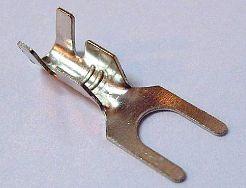 Terminating conductors and wires is better with the use of special tips. Tips come in many different types - for multi-wire and solid, for aluminum and copper cable conductors. For example, for copper stranded cores are available tips made of seamless copper pipe, tapered and drilled under a bolt on one side.
Terminating conductors and wires is better with the use of special tips. Tips come in many different types - for multi-wire and solid, for aluminum and copper cable conductors. For example, for copper stranded cores are available tips made of seamless copper pipe, tapered and drilled under a bolt on one side.
Such a tip can be of two modifications: uncoated and electrolytically tinned (TM and TML, respectively). The marking of these tips is as follows: TM (TML) -XX-UU. Here, ХХ is the wire section for the clamp, and УУ is the diameter of the tip hole for the mounting bolt. The same designations of sizes are used, by the way, for tips of other brands.
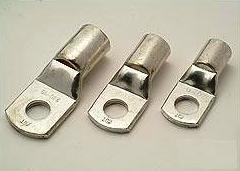 Tips TM and TML are attached crimping (for more information about crimping wires, see here) But this does not mean that they can be flattened with a hammer or clamped with pliers. Should be applied special crimping pliershaving a hydraulic or manual drive. Ticks can crimp the tip at one point along its center, or can at two along the edges. The number of crimps should be at least two - for reliable fixation of the wire and good electrical contact.
Tips TM and TML are attached crimping (for more information about crimping wires, see here) But this does not mean that they can be flattened with a hammer or clamped with pliers. Should be applied special crimping pliershaving a hydraulic or manual drive. Ticks can crimp the tip at one point along its center, or can at two along the edges. The number of crimps should be at least two - for reliable fixation of the wire and good electrical contact.
By the way, single-wire, solid cable conductors can also be crimped with such terminals, but with careful selection of crimping dies of pincers. If the size is chosen incorrectly, the core can simply break off. Before mounting the ferrules, crimping the wire or core must be stripped from insulation and oxide to shiny metal.
Copper lugs are used for pressure testing quite often - for connecting cable risers in the input distribution switchgear, for grounding metal switchboards, for connecting electric stoves, etc. And in industry, they find their application all the time.
They can be crimped with copper conductors with a cross section of 2.5 to 240 square meters. mm In this case, tinned TML tips are used mainly in critical electrical connections where increased corrosion resistance is required.
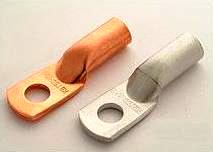 Another less common group of cable lugs is crimping tips with a control window - TML (o). This, as can be seen from the marking, is the same lugs from a copper seamless pipe, but their peculiarity is in the control window, which allows you to see if the wire fell into place.
Another less common group of cable lugs is crimping tips with a control window - TML (o). This, as can be seen from the marking, is the same lugs from a copper seamless pipe, but their peculiarity is in the control window, which allows you to see if the wire fell into place.
TML (o) tips can also be mounted by soldering - pouring molten solder into the tip hole, after inserting a wire that has been treated with a neutral flux and cleaned from insulation. TML (o) - the most responsible tips, they are used only in industry, so many electricians working in the housing sector do not even know about their existence.
Aluminum Copper Cable Terminals (TAM) better known to such electricians. They are used to connect aluminum wires to the copper busbars of input and input distribution devices. To some, the tip, half made of copper and half made of aluminum, will seem incredible. Nevertheless, the shank of this tip is aluminum, and it is copper and these two parts are connected due to frictional diffusion without any transition resistance. Alumina tips are mounted with the same crimping.
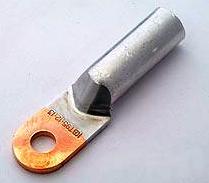 Most often, the conductors of aluminum cables are crimped ordinary aluminum tips (TA brand). These cable lugs are in all respects similar to TM lugs, except for their material, but the minimum size of their wire holes is 16 square meters. mm., in accordance with the current requirements of the PUE.
Most often, the conductors of aluminum cables are crimped ordinary aluminum tips (TA brand). These cable lugs are in all respects similar to TM lugs, except for their material, but the minimum size of their wire holes is 16 square meters. mm., in accordance with the current requirements of the PUE.
Do not forget that any aluminum core or wire is terminated only with the use of special quartz-vaseline lubricant, eliminating the problem of the formation of a harmful non-conductive oxide film on the surface of the conductor.
Copper cores and wires, for example, in household appliances such as washing machines, microwave ovens and the same electric stoves, are often terminated copper solder tips. These tips are made of stamped sheet metal, the shape of which provides for special "ears". "Ears" can be brought together and fixed wire. If this design is also soldered, then the transition resistance is almost completely eliminated.
An example of such a tip can be considered PM tipsWhose "ears" are already factory-made. Therefore, they are sometimes fixed with conventional crimping, without soldering. PM tips are available for conductors with a cross section from 2.5 to 240 square meters. mm
Appearance pin cable lugs contributed to one specific problem. The fact is that modern switchgears (switchboards, such as ЩРН and ЩРВ) tend to reduce overall dimensions.
The same can be said about switching devices and protection devices and, first of all, about circuit breakers. The dimensions are reduced - the dimensions of the clamping devices are also reduced. Here traditional bolt tips do not fit in any way - you need a pin that is neat and compact. Therefore, pin tips, for example, NSHP, are used more and more often.
In industry, for connecting power cables with a cross section of 25 to 240 square meters. mm Recently, another type of cable lugs is often used. They are called “bolted” or “mechanical”. Their marking is NB.
These tips are made of an aluminum alloy that is resistant to corrosion, and the wire in them is clamped using shear bolts. Copper wires and cores for installation in such lugs must be tinned beforehand. A heat shrinkable tube is usually included with the tips of the NB to ensure tightness.
I must say that, despite the variety of factory tips, the designs of which we have listed, many still use homemade tips of the most custom sizes. After all, to make such a tip is very simple: flattened the pipe from one end and drilled a hole. Of course, the permissible current load of such a tip remains unknown, but when grounding a private house, for example, such tips are used very often.
In addition, we note that in domestic installation (and sometimes even in industrial) tips are often completely neglected, reconciled or not knowing about the high transition resistance.So solid cores and wires are often simply bent into a ring under a bolt or inserted into the clamp as is. Stranded wires in the best case are simply crowded, and when mounted under a bolt, they are twisted into a loop, the resistance of which very much depends on the skill level and the skills of an electrician.
Alexander Molokov
See also at bgv.electricianexp.com
:
